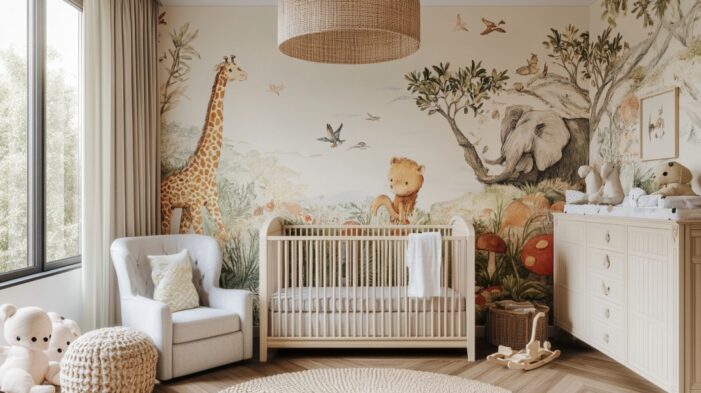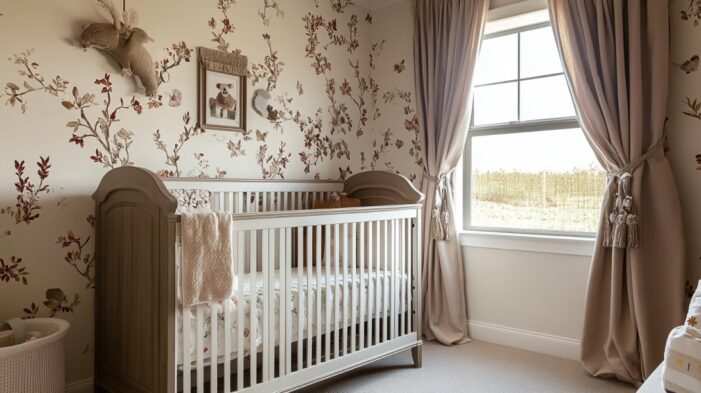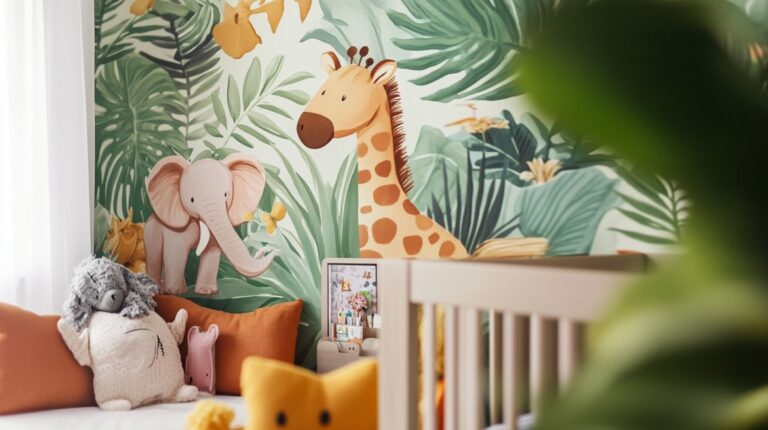Decorating your child’s space is one of those rare parenting joys where practicality and imagination finally align. You’re not just choosing colors. You’re setting the emotional tone of their early memories.
Animal themed wallpaper does more than look adorable—it turns bare walls into a world your child can grow up with.
Key Highlights
- Animal prints create emotional bonds and spark storytelling
- Peel-and-stick wallpaper offers stress-free updates as kids grow
- Wall designs can visually structure zones for play, sleep, and reading
- Choose calming animals and colors for better naps and bedtime
- Use feature walls to avoid visual clutter and maintain flexibility
- Animal wallpaper fits every design—modern, vintage, boho, or rustic
Not Just Cute—Smart Room Planning for Real Life

Parents deal with chaos. Toys everywhere, laundry piling up, snacks half-eaten under beds. A smart layout helps.
Animal themed wallpaper can actually help you zone your space. You don’t need four covered walls. Instead, choose one “hero wall” to anchor the room. Use it behind the crib, above the reading bench, or along the play corner. That one element draws the eye, hides imperfections, and adds intentionality to the room without overwhelming it.
- Use bold prints behind shelves to create depth
- Add soft-toned wallpaper near cribs to encourage calm
- Place animal murals near play areas to boost energy and creativity
Make the Wallpaper Work Harder Than Paint
Let’s face it—paint is fine. But it’s predictable. Wallpaper lets you layer personality, pattern, and texture. It’s a parenting shortcut to “looks like I tried really hard” when you barely had time to vacuum.
Here’s what wallpaper does better than paint:
| Feature | Paint | Peel-and-Stick Themed Wallpapers |
| Visual Storytelling | ❌ None | ✅ Instantly adds animals and scenes |
| Textural Depth | ❌ Flat | ✅ Adds movement and softness |
| Easy Change with Growth | ❌ Needs repaint | ✅ Reposition or remove anytime |
| Kid Engagement | ❌ Limited | ✅ Boosts learning, imagination |
When decorating for a baby, pick soft watercolor-style animals. For toddlers, go for bolder shapes and contrasting colors. Kids engage more with high-contrast visuals, which also stimulate early brain development.
Storage Meets Style: Practical Tricks Using Wallpaper

Here’s a secret most designers won’t tell you—wallpaper isn’t just for walls.
- Line the backs of open toy shelves
- Wrap drawer fronts on a changing table
- Create visual separation between zones in a shared room
Let’s say you’ve got one room doing double duty: half nursery, half toddler play zone. Use wallpaper behind the crib in soft colors (like rabbits or deer), and use more vibrant prints (like jungle animals) on the opposite wall where the toys live. That subtle split helps your child know where calm happens—and where chaos is allowed.
Kid-Friendly Doesn’t Have to Mean “Too Loud”
One mistake many parents make: going too bright, too cartoonish. That kind of decor burns out fast.
- Stick with nature-inspired tones: moss green, sandy beige, sky blue
- Avoid red-heavy palettes in nurseries—studies show they overstimulate
- Mix patterns with solids: pair your animal wall with plain linen curtains or a jute rug
And yes, you can have giraffes and still look like an adult lives there too.

The Link Between Child’s Emotion and Design
Children process the world visually long before they can talk. What surrounds them—color, pattern, shape—affects how safe, calm, or stimulated they feel. That’s why animal themed wallpaper isn’t just decoration. It becomes part of their emotional foundation.
Animal imagery offers comfort through familiarity and symbolism. These aren’t just random creatures on the wall—they carry meanings that kids intuitively pick up on.
What the animals represent:
- Lions show up in bold poses. Even if stylized in soft tones, they send a message: strength, courage, and leadership. A lion on the wall becomes a silent reassurance that “you’ve got this,” especially for shy or anxious children.
- Owls often perch above in serene designs. They represent watchfulness and wisdom. Kids pick up on their quiet presence and come to see them as calm guardians, especially in reading nooks or near beds.
- Bears, especially in nursery prints, are rarely roaring. They’re curled up or gently walking. They symbolize protection and nurturing. A bear wallpaper near the crib or changing station adds a layer of emotional security.
- Bunnies evoke softness and calm. Their relaxed posture and gentle eyes help signal that the space is safe, warm, and perfect for quiet time.
You may not narrate these meanings out loud, but your child absorbs them. The animal characters become emotional anchors. Some will become part of their play, others part of their bedtime rituals. Many parents find that their child forms a bond with a specific animal—talking to it, including it in stories, even pointing to it during moments of stress.
- Design Tip for Parents: Pair wallpaper animals with matching stuffed animals, mobile figures, or book characters. When your child sees the same friendly faces across different elements of the room, the emotional effect multiplies. You’re building a world of safety through gentle repetition.
- The Science Behind It: Neuroscience research shows that infants and toddlers respond strongly to visual cues in their environment. When those cues feel safe and consistent, cortisol (the stress hormone) drops, and sleep improves. That translates into longer naps, better bedtime transitions, and smoother play periods.
By choosing wallpaper with care—not just for trend or color—you’re shaping emotional development in quiet, meaningful ways. You don’t need flashy toys or overstimulating decor. You need walls that feel like a hug.
Your Child’s First “Book” Is the Wall
Even before they speak, babies look. They stare. They learn patterns. An animal mural becomes their first introduction to characters and story.
- Label animals out loud during diaper changes
- Ask questions like “Where’s the giraffe?” before naps
- Tell bedtime stories using animals on the wall as characters
You’ve just turned décor into an interactive toy. No batteries required.
How to Choose the Right Wallpaper for Your Home

- Pick the wall you want to decorate. Behind the crib or playmat works best.
- Choose a theme that matches your home’s tone—modern, vintage, or boho.
- Measure the wall twice. Always add 10% extra for trimming.
- Order samples before committing. Check how it looks in day and night light.
- Install during naptime or after bedtime. It’s a quiet, easy DIY.
And remember, if you change your mind in six months, peel it off. No drama.
Final Thought for Tired Parents
Don’t overthink it. Your child’s room doesn’t need to be perfect. It just needs to feel loved. Animal themed wallpaper makes the space feel alive, without making you feel overwhelmed. You get function and fantasy in one move.
Create the kind of room you would have loved as a child. Because one day, your kid will remember those quiet mornings with the owls, the story nights with the giraffes, and how the walls made everything feel okay.

